The AI-powered behavioral therapy market is projected to reach USD 2741.8 million by 2035, recording an absolute increase of USD 1,760.8 million over the forecast period. The market is valued at USD 992.1 million in 2025 and is set to rise at a CAGR of 10.7% during the assessment period. The overall market size is expected to grow by nearly 2.8 times during the same period, supported by increasing demand for accessible mental health solutions and advanced therapeutic technologies worldwide, driving demand for intelligent therapy platforms and increasing investments in digital health applications and mental wellness technologies globally. However, regulatory compliance requirements and privacy concerns may pose obstacles to market expansion.
The convergence of artificial intelligence and behavioral therapy represents a transformative shift in mental health care delivery, addressing critical gaps in accessibility, affordability, and availability of therapeutic services. Traditional therapy models face significant constraints including limited practitioner availability, high costs, and scheduling restrictions that prevent millions from accessing needed mental health support. AI-powered behavioral therapy systems leverage sophisticated algorithms, natural language processing, and machine learning capabilities to provide continuous, personalized therapeutic interventions that can adapt to individual user needs and responses in real-time.
Machine learning algorithms analyze vast datasets of therapeutic interactions, symptom patterns, and treatment outcomes to identify effective intervention strategies for specific mental health conditions. These systems can process and respond to emotional cues, behavioral indicators, and linguistic patterns that suggest changes in mental state, enabling proactive therapeutic support when users need it most. Advanced natural language processing capabilities allow these platforms to engage in meaningful therapeutic conversations, employing evidence-based techniques from cognitive behavioral therapy, dialectical behavior therapy, and other established therapeutic modalities.
The democratization of mental health support through AI-driven platforms addresses fundamental healthcare disparities by providing consistent, high-quality therapeutic guidance regardless of geographic location, economic status, or time constraints. Corporate wellness programs increasingly incorporate these technologies to support employee mental health, recognizing the direct correlation between psychological wellbeing and productivity metrics. Insurance providers are evaluating AI-powered therapy solutions as cost-effective alternatives to traditional therapy sessions, particularly for mild to moderate anxiety and depression cases.
Clinical research continues to validate the efficacy of AI-powered interventions for specific mental health conditions, with studies demonstrating comparable outcomes to human-delivered therapy for certain populations and conditions. These platforms generate comprehensive data on user interactions, therapeutic progress, and treatment adherence, providing valuable insights for both individual care optimization and broader mental health research initiatives. The technology's ability to provide immediate crisis intervention and continuous monitoring capabilities addresses critical safety concerns in mental health care delivery.
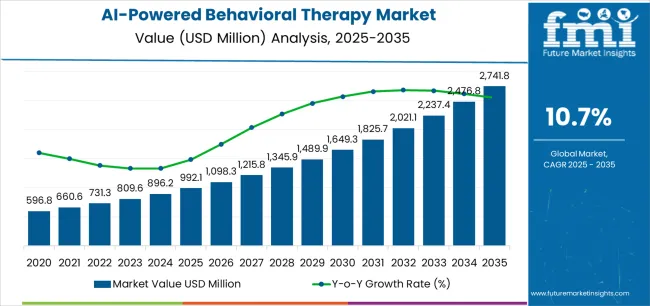
AI-Powered Behavioral Therapy Market Key Takeaways
| Metric | Value |
|---|---|
| Market Value (2025) | USD 992.1 million |
| Market Forecast Value (2035) | USD 2741.8 million |
| Forecast CAGR (2025 to 2035) | 10.7% |
AI-Powered Behavioral Therapy Market Year-over-Year Forecast (2025-2035)
Between 2025 and 2030, the AI-powered behavioral therapy market is projected to expand from USD 992.1 million to USD 1,711.6 million, resulting in a value increase of USD 719.5 million, which represents 40.9% of the total forecast growth for the decade. This phase of development will be shaped by rising demand for accessible mental health solutions and intelligent therapeutic platforms, product innovation in chatbot technologies and biofeedback applications, as well as expanding integration with healthcare systems and corporate wellness applications. Companies are establishing competitive positions through investment in natural language processing capabilities, advanced therapeutic algorithms, and strategic market expansion across individual, clinical, and enterprise applications.
From 2030 to 2035, the market is forecast to grow from USD 1,711.6 million to USD 2741.8 million, adding another USD 1,041.3 million, which constitutes 59.1% of the overall ten-year expansion. This period is expected to be characterized by the expansion of advanced AI therapeutic applications, including sophisticated emotion recognition systems and next-generation personalized treatment protocols tailored for specific mental health conditions, strategic collaborations between AI therapy providers and healthcare organizations, and an enhanced focus on clinical validation standards and evidence-based treatment protocols. The growing emphasis on mental health accessibility and digital therapeutics will drive demand for comprehensive AI-powered therapy solutions across diverse healthcare applications.
The AI-powered behavioral therapy market grows by enabling healthcare providers and mental health organizations to optimize treatment accessibility while accessing advanced therapeutic technologies without substantial in-house development investment.
Healthcare companies and mental health practitioners face mounting pressure to develop scalable therapy solutions and personalized treatment capabilities while managing complex patient care requirements, with intelligent AI systems typically providing 40-60% improvement in treatment accessibility compared to traditional alternatives, making advanced therapeutic platforms essential for competitive healthcare positioning. The healthcare industry's need for continuous mental health support and application-specific therapeutic capabilities creates demand for comprehensive AI therapy solutions that can provide superior accessibility, maintain consistent treatment standards, and ensure reliable operation without compromising care quality or therapeutic effectiveness.
Government initiatives promoting digital health technologies and mental health accessibility drive adoption in healthcare delivery, corporate wellness programs, and individual therapeutic applications, where treatment availability has a direct impact on patient outcomes and long-term healthcare effectiveness. However, regulatory complexity constraints during healthcare implementation projects and the expertise requirements for clinical integration may limit accessibility among smaller healthcare providers and regions with limited technical infrastructure for advanced therapeutic technologies.
The market is segmented by product type, application, technology, end user, and region. By product type, the market is divided into AI therapy chatbots & virtual companions, cognitive behavioral therapy apps, AI-driven biofeedback devices, AI-powered sleep & stress management tools, and emotion recognition & monitoring systems. Based on application, the market is categorized into anxiety & depression, ADHD & cognitive disorders, sleep disorders, substance abuse & addiction, and post-traumatic stress disorder.
By technology, the market includes machine learning, natural language processing, deep learning, and emotion AI/affective computing. By end user, the market includes individuals, mental health clinics/hospitals, corporate wellness providers, payers & insurers, and academic/research institutes. Regionally, the market is divided into Asia Pacific, Europe, North America, and other key regions.
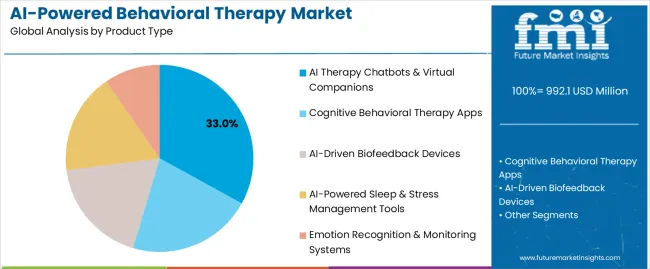
The AI therapy chatbots & virtual companions segment represents the dominant force in the AI-powered behavioral therapy market, capturing approximately 33.0% of total market share in 2025, projected to reach 33.0% by 2035. This established product category encompasses solutions featuring advanced conversational AI and virtual therapeutic assistance applications, including high-performance natural language processing capabilities and enhanced personalization characteristics that enable superior therapeutic benefits and treatment outcomes across all mental health applications.
The chatbots & virtual companions segment's market leadership stems from its proven therapeutic capabilities, with solutions capable of addressing diverse mental health requirements while maintaining consistent interaction standards and therapeutic effectiveness across all treatment environments.
The cognitive behavioral therapy apps segment maintains a substantial 28.0% market share in 2025, expected to reach 27.5% by 2035, serving therapeutic applications that require structured treatment protocols with enhanced clinical effectiveness for individual users and healthcare organizations. These solutions offer advanced therapeutic methodologies for complex mental health conditions while providing sufficient personalization characteristics to meet clinical and individual treatment demands. The AI-driven biofeedback devices segment accounts for approximately 13.5% of the market in 2025, projected to grow to 15.8% by 2035, serving applications requiring physiological monitoring properties or specialized therapeutic configurations.
Key product type advantages driving the chatbots & virtual companions segment include:
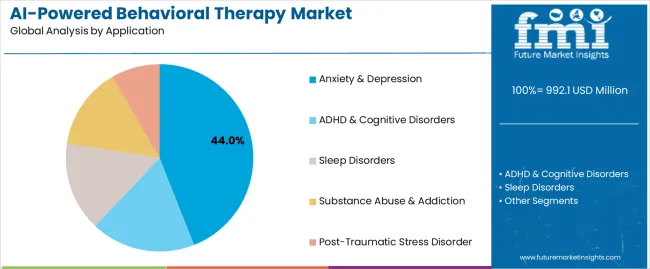
Anxiety & depression applications dominate the AI-powered behavioral therapy market with approximately 44.0% market share in 2025, projected to reach 40.0% by 2035, reflecting the critical role of AI therapy in supporting specialized mental health treatment requirements and therapeutic performance worldwide. The anxiety & depression segment's market leadership is reinforced by increasing mental health awareness trends, treatment complexity requirements, and rising needs for accessible therapeutic capabilities in healthcare applications across developed and emerging markets.
The ADHD & cognitive disorders segment represents the second-largest application category, capturing 18.5% market share in 2025, expected to reach 20.2% by 2035, through specialized requirements for cognitive support systems, attention management applications, and neurological therapeutic processes. This segment benefits from growing cognitive health demand that requires specific treatment requirements, clinical compliance standards, and therapeutic optimization protocols in healthcare markets.
The sleep disorders segment accounts for 15.0% market share in 2025, projected to reach 15.5% by 2035, serving sleep management applications, circadian rhythm therapy, and specialized sleep-related therapeutic interventions across various healthcare sectors.
Key market dynamics supporting application growth include:
The market is driven by three concrete demand factors tied to healthcare and therapeutic outcomes. First, advanced mental health accessibility and digital therapeutic solutions create increasing demand for AI-powered therapy systems, with treatment enhancement of 15-25% annually in major healthcare applications worldwide, requiring comprehensive therapeutic technology infrastructure.
Second, government initiatives promoting digital health technologies and mental health accessibility drive increased adoption of AI therapy platforms, with many countries implementing healthcare digitization programs and regulatory frameworks for therapeutic advancement by 2030. Third, technological advancements in machine learning and natural language processing enable more efficient and effective therapeutic solutions that improve patient outcomes while reducing treatment costs and accessibility barriers.
Market restraints include complex regulatory requirements and validation costs for AI therapy platforms that can challenge market participants in developing compliant therapeutic capabilities, particularly in regions where regulatory pathways for digital therapeutics remain evolving and uncertain. Technical complexity of advanced AI systems and clinical integration requirements pose another significant challenge, as AI therapy demands sophisticated algorithms and therapeutic protocols, potentially affecting development costs and operational efficiency. Privacy constraints from sensitive mental health data across different healthcare applications create additional operational challenges for providers, demanding ongoing investment in data security development and compliance assurance programs.
Key trends indicate accelerated adoption in Asia-Pacific markets, particularly India and China, where healthcare digitization and mental health awareness drive comprehensive AI therapy adoption. Technology integration trends toward advanced therapeutic AI systems with enhanced personalization characteristics, sophisticated emotion recognition applications, and integrated healthcare solutions enable effective treatment approaches that optimize therapeutic efficiency and minimize accessibility barriers. However, the market thesis could face disruption if significant advances in traditional therapy methods or major changes in mental health treatment paradigms reduce reliance on AI-powered therapeutic applications.
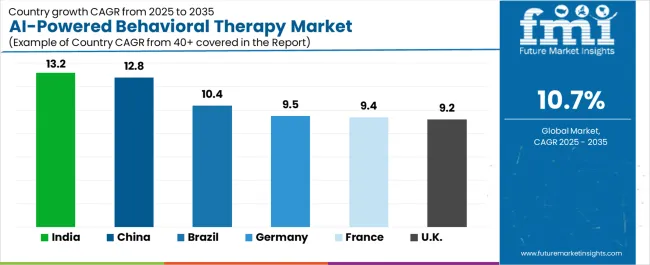
| Countries | CAGR (%) |
|---|---|
| India | 13.2 |
| China | 12.8 |
| Brazil | 10.4 |
| Germany | 9.5 |
| France | 9.4 |
| UK | 9.2 |
The global AI-powered behavioral therapy market is expanding rapidly, with India leading at a 13.2% CAGR through 2035, driven by healthcare digitization, government mental health initiatives, and advanced therapeutic platforms. China follows at 12.8%, supported by healthcare modernization, large-scale digital health programs, and AI development initiatives. Brazil records 10.4%, reflecting growing healthcare investment with increasing integration in mental health and wellness applications. Germany grows at 9.5%, anchored by healthcare innovation and strong digital health adoption. France advances at 9.4%, leveraging healthcare excellence and digital therapeutic integration, while UK grows steadily at 9.2%, emphasizing clinical precision and therapeutic innovation.
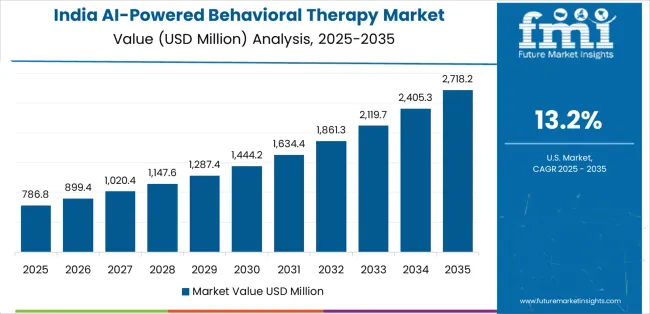
India demonstrates the strongest growth potential in the AI-powered behavioral therapy market with a CAGR of 13.2% through 2035. The country's leadership position stems from healthcare sector digitization, government-backed mental health initiatives, and comprehensive digital health regulations driving the adoption of advanced AI therapy solutions.
Growth is concentrated in major healthcare and technology centers, including Mumbai, Delhi, Bangalore, and Hyderabad, where healthcare companies and mental health organizations are implementing advanced AI therapy systems for enhanced treatment capabilities and patient accessibility. Distribution channels through digital health platforms and healthcare providers expand deployment across medical facilities and wellness development initiatives. The country's Ministry of Health and Family Welfare provides policy support for digital health technology modernization, including comprehensive mental healthcare capability development programs.
Key market factors:
In major healthcare and technology centers including Beijing, Shanghai, Shenzhen, and Guangzhou, the adoption of comprehensive AI therapy solutions is accelerating across healthcare projects and mental health development initiatives, driven by healthcare modernization and government digital health programs. The market demonstrates strong growth momentum with a CAGR of 12.8% through 2035, linked to comprehensive healthcare digitization and increasing focus on mental health efficiency solutions. Chinese companies are implementing advanced AI therapy systems and treatment platforms to enhance healthcare performance while meeting growing demand in expanding mental health and wellness sectors. The country's healthcare development initiatives create continued demand for AI therapy technologies, while increasing emphasis on innovation drives adoption of advanced therapeutic systems.
Key development areas:
Brazil's market expansion is driven by diverse healthcare demand, including mental health development in major cities and comprehensive wellness projects across multiple regions. The country demonstrates strong growth potential with a CAGR of 10.4% through 2035, supported by federal healthcare programs and industry-level mental health development initiatives. Brazilian companies face implementation challenges related to healthcare complexity and scaling requirements, requiring strategic development approaches and support from specialized AI therapy partners. However, growing healthcare demands and advancing treatment requirements create compelling business cases for AI therapy adoption, particularly in mental health areas where accessible technologies have a direct impact on therapeutic success and healthcare competitiveness.
Market characteristics:
The Germany market leads in advanced healthcare innovation based on integration with medical systems and precision therapeutic technologies for enhanced treatment performance. The country shows strong potential with a CAGR of 9.5% through 2035, driven by the modernization of existing healthcare infrastructure and the expansion of advanced medical facilities in major healthcare areas, including Bavaria, Baden-Württemberg, North Rhine-Westphalia, and Lower Saxony. German companies are adopting intelligent AI therapy systems for treatment improvement and efficiency enhancement, particularly in regions with advanced healthcare requirements and medical applications demanding comprehensive technology upgrades. Technology deployment channels through established medical institutions and healthcare operators expand coverage across treatment facilities and innovation-focused applications.
Leading market segments:
France's AI-powered behavioral therapy market demonstrates established and innovation-focused landscape, characterized by growing integration of therapeutic technologies with existing healthcare infrastructure across medical projects, treatment networks, and modernization initiatives. France's emphasis on healthcare excellence and therapeutic innovation drives demand for advanced AI therapy solutions that support comprehensive medical initiatives and treatment requirements in healthcare operations.
The market benefits from partnerships between international AI therapy providers and domestic healthcare leaders, creating service ecosystems that prioritize therapeutic excellence and treatment programs. Medical centers in major regions showcase developing AI therapy implementations where therapeutic systems achieve efficiency improvements through integrated healthcare programs.
UK's AI-powered behavioral therapy market demonstrates advanced implementation focused on clinical precision and healthcare performance optimization, with documented integration of therapeutic AI systems, achieving 40% improvement in treatment efficiency across healthcare and mental health facilities. The country maintains steady growth momentum with a CAGR of 9.2% through 2035, driven by healthcare facilities' emphasis on clinical excellence and continuous operational methodologies that align with British healthcare standards applied to AI therapy operations. Major healthcare areas, including England, Scotland, Wales, and Northern Ireland, showcase advanced deployment of AI therapy platforms where therapeutic systems integrate seamlessly with existing healthcare infrastructure and comprehensive quality management programs.
Key market characteristics:
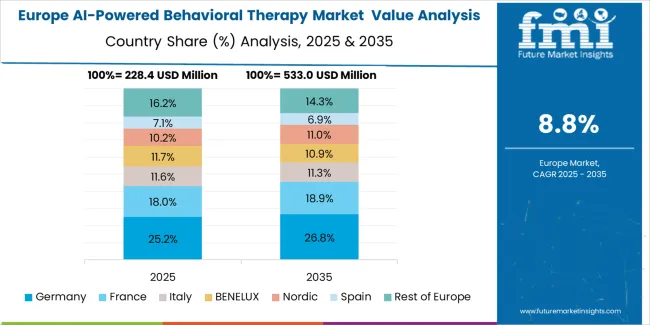
The AI-powered behavioral therapy market in Europe is projected to grow from USD 298.0 million in 2025 to USD 827.0 million by 2035, registering a CAGR of 10.8% over the forecast period. Germany is expected to maintain its leadership position with a 24.2% market share in 2025, projected to reach 24.5% by 2035, supported by its extensive healthcare infrastructure, advanced medical facilities, and comprehensive digital health networks serving major European markets.
United Kingdom follows with a 20.1% share in 2025, projected to reach 20.3% by 2035, driven by comprehensive healthcare programs in major medical regions implementing advanced AI therapy systems. France holds a 18.8% share in 2025, expected to maintain 18.6% by 2035 through the ongoing development of healthcare facilities and therapeutic networks. Italy commands a 15.4% share, while Spain accounts for 12.2% in 2025. The Rest of Europe region is anticipated to gain momentum, expanding its collective share from 9.3% to 9.1% by 2035, attributed to increasing AI therapy adoption in Nordic countries and emerging Eastern European healthcare facilities implementing digital health programs.
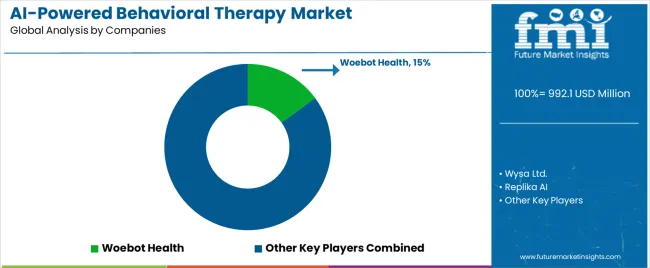
The AI-powered behavioral therapy market features approximately 15-20 meaningful players with moderate concentration, where the top three companies control roughly 30-35% of global market share through established therapeutic portfolios and extensive healthcare relationships. Competition centers on therapeutic effectiveness, clinical validation, and technological sophistication rather than price competition alone.
Market leaders include Woebot Health, Wysa Ltd., and Replika AI, which maintain competitive advantages through comprehensive AI therapy portfolios, advanced natural language processing capabilities, and deep expertise in the mental health and digital therapeutics sectors, creating high switching costs for users. These companies leverage established healthcare relationships and ongoing clinical partnerships to defend market positions while expanding into adjacent healthcare and wellness applications.
Challengers encompass Youper Inc. and Talkspace Inc., which compete through specialized therapeutic technologies and strong clinical presence in key healthcare markets. Technology specialists, including X2AI, Ellipsis Health, and Limbic AI, focus on specific AI therapy applications or vertical markets, offering differentiated capabilities in emotion recognition systems, clinical integration platforms, and application-specific therapeutic protocols.
Regional players and emerging AI therapy companies create competitive pressure through innovative algorithmic approaches and rapid development capabilities, particularly in high-growth markets including India and China, where local presence provides advantages in cost optimization and regulatory compliance. Market dynamics favor companies that combine advanced AI technologies with comprehensive healthcare services that address the complete therapeutic lifecycle from initial assessment through ongoing treatment monitoring and clinical support.
AI-powered behavioral therapy solutions represent a critical healthcare technology that enables mental health providers, healthcare organizations, and wellness companies to enhance treatment accessibility and therapeutic quality without substantial ongoing clinical investment, typically providing 40-60% improvement in treatment accessibility compared to traditional alternatives while ensuring unprecedented therapeutic reach and clinical compliance.
With the market projected to grow from USD 992.1 million in 2025 to USD 2741.8 million by 2035 at a 10.7% CAGR, these solutions offer compelling advantages - superior accessibility, enhanced therapeutic effectiveness, and treatment personalization capabilities - making them essential for anxiety & depression applications (44.0% market share), ADHD & cognitive disorders (18.5% share), and diverse mental health applications seeking accessible therapeutic solutions. Scaling market penetration and therapeutic capabilities requires coordinated action across healthcare policy, clinical standards, AI therapy providers, healthcare organizations, and medical institutions.
| Items | Values |
|---|---|
| Quantitative Units (2025) | USD 992.1 Million |
| Product Type | AI Therapy Chatbots & Virtual Companions, Cognitive Behavioral Therapy Apps, AI-Driven Biofeedback Devices, AI-Powered Sleep & Stress Management Tools, Emotion Recognition & Monitoring Systems |
| Application | Anxiety & Depression, ADHD & Cognitive Disorders, Sleep Disorders, Substance Abuse & Addiction, Post-Traumatic Stress Disorder |
| Technology | Machine Learning, Natural Language Processing, Deep Learning, Emotion AI/Affective Computing |
| End User | Individuals, Mental Health Clinics/Hospitals, Corporate Wellness Providers, Payers & Insurers, Academic/Research Institutes |
| Regions Covered | Asia Pacific, Europe, North America, Latin America, Middle East & Africa |
| Countries Covered | India, China, Brazil, Germany, France, UK, and 40+ countries |
| Key Companies Profiled | Woebot Health, Wysa Ltd., Replika AI, Youper Inc., Talkspace Inc., X2AI, Ellipsis Health, Limbic AI, WoeBot Labs |
| Additional Attributes | Dollar sales by product type and application categories, regional adoption trends across Asia Pacific, Europe, and North America, competitive landscape with AI therapy providers and healthcare companies, clinical facility requirements and specifications, integration with healthcare initiatives and wellness platforms, innovations in therapeutic technology and AI systems, and development of personalized applications with clinical quality and therapeutic optimization capabilities. |
The global AI-powered behavioral therapy market is estimated to be valued at USD 992.1 million in 2025.
The market size for the AI-powered behavioral therapy market is projected to reach USD 2,741.8 million by 2035.
The AI-powered behavioral therapy market is expected to grow at a 10.7% CAGR between 2025 and 2035.
The key product types in AI-powered behavioral therapy market are ai therapy chatbots & virtual companions, cognitive behavioral therapy apps, AI-driven biofeedback devices, AI-powered sleep & stress management tools and emotion recognition & monitoring systems.
In terms of application, anxiety & depression segment to command 44.0% share in the AI-powered behavioral therapy market in 2025.






Full Research Suite comprises of:
Market outlook & trends analysis
Interviews & case studies
Strategic recommendations
Vendor profiles & capabilities analysis
5-year forecasts
8 regions and 60+ country-level data splits
Market segment data splits
12 months of continuous data updates
DELIVERED AS:
PDF EXCEL ONLINE
Behavioral Health Market Forecast Outlook 2025 to 2035
Behavioral Biometrics Market Size and Share Forecast Outlook 2025 to 2035
Behavioral Analytics – AI-Powered Cybersecurity & Insights
AI-Enabled Behavioral Therapy Market Size and Share Forecast Outlook 2025 to 2035
IV Therapy and Vein Access Devices Market Insights – Trends & Forecast 2024-2034
Mesotherapy Market Size and Share Forecast Outlook 2025 to 2035
Cryotherapy Market Growth - Demand, Trends & Emerging Applications 2025 to 2035
Aromatherapy Market Size and Share Forecast Outlook 2025 to 2035
Radiotherapy Positioning Devices Market Size and Share Forecast Outlook 2025 to 2035
Cell Therapy Systems Market Size and Share Forecast Outlook 2025 to 2035
Chemotherapy-Induced Nausea And Vomiting Therapeutics Market Size and Share Forecast Outlook 2025 to 2035
Phototherapy Lamps And Units For Aesthetic Medicine Market Size and Share Forecast Outlook 2025 to 2035
Phototherapy Equipment Market Size and Share Forecast Outlook 2025 to 2035
Phototherapy Treatment Market Size and Share Forecast Outlook 2025 to 2035
Heat Therapy Units Market Analysis - Size, Share, and Forecast 2025 to 2035
Chemotherapy Induced Anemia Market Trends and Forecast 2025 to 2035
Radiotherapy Patient Positioning Accessories Market Trends – Forecast 2025 to 2035
Phototherapy Lamps Market Growth - Trends & Forecast 2025 to 2035
Gene Therapy in CNS Disorder Market Analysis by Indication, Type, End User, and Region through 2035
Radiotherapy Device Market is segmented by External Beam Radiation Therapy Device and Internal Beam Radiation Therapy Device from 2025 to 2035

Thank you!
You will receive an email from our Business Development Manager. Please be sure to check your SPAM/JUNK folder too.
Chat With
MaRIA